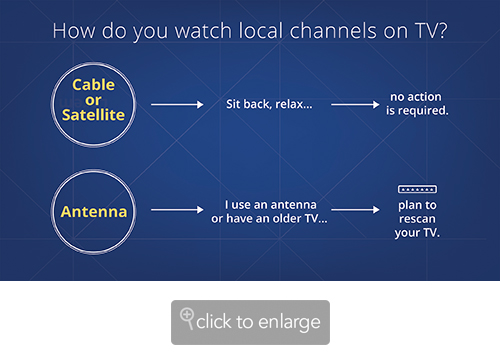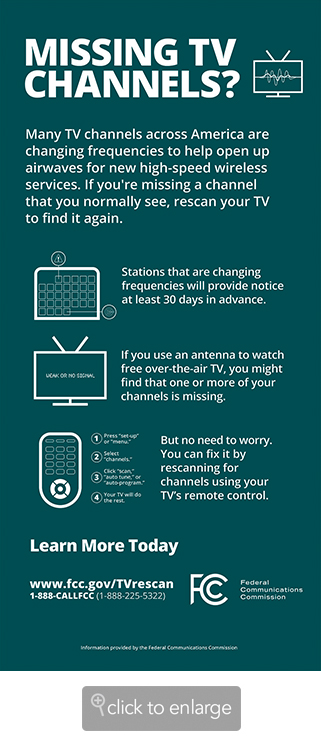(Family Features) If you rely on an antenna for your TV viewing, changes may affect the reception of some of your local channels.
As part of the Federal Communications Commission's (FCC) effort to make more airwaves available for new, high-speed wireless services, some TV stations in cities across the United States are changing their over-the-air broadcast frequencies.
While the channel numbers you see on the TV are not changing, if you watch TV using an antenna, you will need to rescan your television to update to the new frequencies so you can continue receiving the affected channels. You will not need to buy a new TV or purchase a converter box. Only people who use an antenna to watch local channels need to rescan their TVs. Cable and satellite subscribers are not affected by these changes.
 Not all local channels are changing, and frequency changes are happening on a rolling basis through July 2020, meaning that not all channels will change at the same time. You should be on the lookout for announcements on your local TV channels and rescan whenever the stations alert you to any changes taking place or you notice a channel you can normally see is missing. TV stations will give you at least 30 days' notice their channels are changing frequencies.
Not all local channels are changing, and frequency changes are happening on a rolling basis through July 2020, meaning that not all channels will change at the same time. You should be on the lookout for announcements on your local TV channels and rescan whenever the stations alert you to any changes taking place or you notice a channel you can normally see is missing. TV stations will give you at least 30 days' notice their channels are changing frequencies.
For more information and tips on how to rescan, visit fcc.gov/TVrescan or call 1-888-CALLFCC (1-888-225-5322).
Common Transition Questions
How will I know it's time to rescan?
Some local TV channels will change frequencies at various times through mid-2020. Your local TV stations will announce their specific "rescan days" on which you will need to rescan. You should be on the lookout for public service announcements and "crawls" running across your TV screen. Broadcasters will provide at least 30 days' notice that their channel is changing frequency.
A good rule of thumb is to rescan your TV anytime you notice that a channel is missing. If you haven't rescanned in a while, you may be surprised by how many other channels are now available.
Who will be affected by the transition?
People who watch television for free with an antenna will be affected. Millions of consumers across the country watch free, over-the-air TV using an antenna.
Will the TV stations change channel numbers?
No, the channel numbers you see on your TV are not changing, but you will need to rescan your television to update to the new frequencies so you can continue receiving those same channels.
 How can I find out which TV stations are changing frequencies?
How can I find out which TV stations are changing frequencies?
The FCC website has an interactive map where you can insert your address to see which of your local TV channels will be changing and the dates you should be watching for the station to announce its "rescan day." To access the map, visit fcc.gov/media/engineering/dtvmaps.
Once you enter your location information, you will see a list of TV stations in your area. Stations that are changing frequencies will have an "R" in the last column (marked "IA"). Click on each station with an "R" to see the time period during which a particular station will make the change. To find out the specific "rescan day" for a particular station, watch for on-air announcements and notices or check the local TV channel website for information.
What is the advantage of making the frequency changes?
The benefit is that more airwaves will be available to meet consumer demand for increased mobile broadband capacity, new 5G wireless and other advanced high-speed mobile services currently being developed.
How can I find more information?
For more information and tips on how to rescan, visit fcc.gov/TVrescan or call 1-888-CALLFCC (1-888-225-5322).
How to Rescan Your TV
Rescanning your TV to pick up the new frequencies is the same process you used to find your local channels when you first set up your TV.
To rescan, on your TV remote control, press "menu" then look for "channel scan," "program," "rescan," "auto tune" or "auto search" in the "setup" or "channel" function.
Even without these frequency changes, it is typically a good idea to periodically rescan your TV to update the channels you receive. While some TVs do this automatically, you may need to select "scan" or "auto-tune" from the TV's menu to start the scanning process.
If you have difficulty, consult the TV owner's manual or the manufacturer's customer service line for more detailed instructions on how to run a channel scan to find local TV channels. If you need to contact customer service, you can find that information in your TV instruction manual or on the manufacturer's website.
Once the rescan is complete, you should receive all available digital TV channels through your antenna. Except in rare circumstances, no new equipment or services are required.
Photo courtesy of Getty Images

